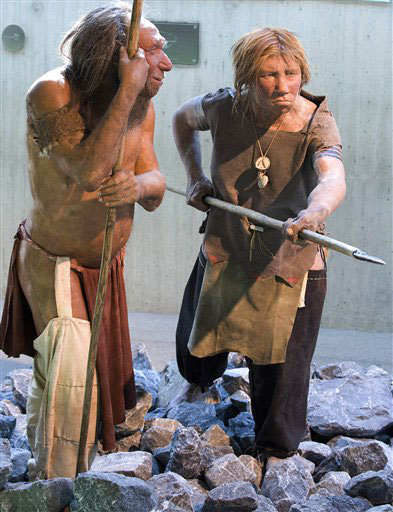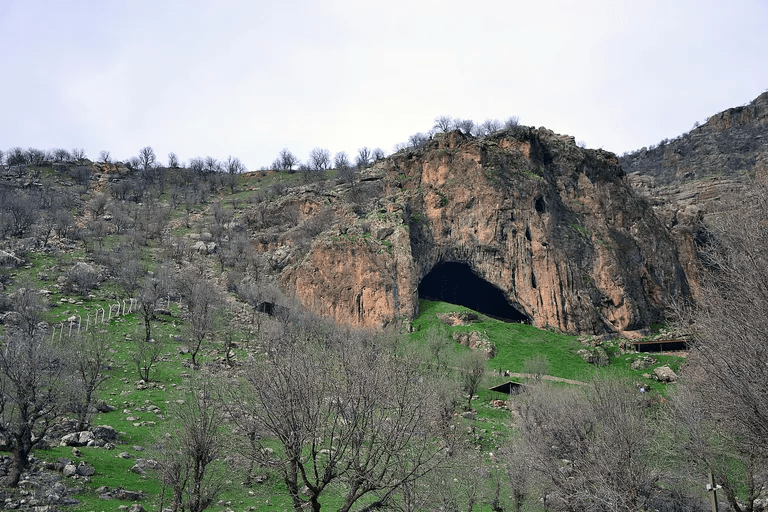Today we have seen that much of what exists in the popular concept of Neanderthals – as dim, stooped, hairy and primitive – is largely down to a combination of Victorian period biases in how people viewed one another (and themselves) as well as an error made in the first reconstructions of Neanderthal skeletons. While we know that this popular image of Neanderthals is wrong, it can also be hard to move away from something that we as human societies have had with us for so long.

Instead of the hairy and primitive animal shown in the above and other pictures, we have seen that Neanderthals looked a lot like us. They were smart and capable, just like we are. They made good use of the landscapes around where they lived, and chose their home bases with care. They invented new technologies for making composite tools, and for keeping themselves warm. Neanderthals even seem to have made decorations for themselves or their clothing, and to have used pigments to add colour to themselves and their possessions. They may even have used these pigments to make paintings on the walls of caves.


Neanderthals even buried their dead. This was not a practice which was restricted to a few Neanderthals living in only one region, but is something which we see repeatedly across the Near East and Europe. This is something which we have seen repeatedly at Shanidar cave, where many Neanderthal burials have been found. At least one of which burials may have had flowers and other plants buried with them as grave goods.

Neanderthals may also have made music, as is suggested by the discovery of a small flute-like instrument from the site of Divje Babe in Slovenia. While small and currntly broken, this ‘flute’ makes beautiful music.
Episode Bibliography:
Arensburg, B., Schepartz, L.A., Tillier, A.M., Vandermeersch, B. and Rak, Y. 1990. A reappraisal of the anatomical basis for speech in Middle Palaeolithic hominids. American Journal of Physical Anthropology 83:137-146.
Bar-Yosef, O. 1998. The chronology of the Middle Palaeolithic of the Levant. In T. Akazawa, K. Aoki and O. Bar-Yosef (eds). Neanderthals and Modern Humans in Western Asia. London: Plenum Press: 39-56.
Bocherens, H. 2009. Neanderthal dietary habits: review of the isotopic evidence. In J.J. Hublin and M.P. Richards (eds.), The Evolution of Hominin Diets: Integrating Approaches to the Study of Palaeolithic Subsistence. London: Springer: 241-250.
Boëda, E., Connan, J. and Muhesen, S. 1998. Bitumen as halfting material on Middle Palaeolithic artefacts from the El Kowm Basin, Syria. In T. Akazawa, K. Aoki and O. Bar-Yosef (eds). Neanderthals and Modern Humans in Western Asia. London: Plenum Press: 181-204.
Burdukiewicz, J.M. 2014. The origin of symbolic behaviour of Middle Palaeolithic humans: recent controversies. Quaternary International 326-327: 398-405.
Gibson, K.R. 2007 Putting it all Together: a constructionist approach to the evolution of human mental capacities. In P. Mellars, K. Boyle, O. Bar-Yosef and C Stringer (eds.), Rethinking the Human Revolution: New Behavioural and Biological Perspectives on the Origins and Dispersal of Modern Humans. Cambridge: McDonald Institute Monographs: 67-78.
Hardy, B.L., Moncel, M.-H., Daujeard, C., Fernandes, P., Béarez, P., Desclaux, E., Chacon Navarro, M.C., Puaud, S. and Gallotti, R. 2013. Impossible Neanderthals? Making string, throwing projectiles and catching small game during Marine Isotope Stage 4 (Abri du Maras, France). Quaternary Science Reviews 82: 23-40.
Henry, D.O., Belmaker, M. and Bergin, S.M. 2017. The effect of terrain on Neanderthal ecology in the Levant. Quaternary International 435: 94-105.
Heydari-Guran, S. and Ghasidian, E. 2020. Late Pleistocene hominin settlement patterns and population dynamics in the Zagros mountains: Kermanshah region. Archaeological Research in Asia 21: 100161.
Hoffmann, D.L., Standish, C.D., Garcia-Diez, M., Pettit, P.B., Milton, J.A., Zilhão, J., Alcolea-Gonzalex, J.J., Cantalejo-Duarte, P., Collado, H., de Balbin, R., Lorblanchet, M., Ramos-Munoz, J., Weniger, G.-Ch. and Pike, A.W.G. 2018. U-Th dating of carbonate crusts revels Neanderthal origin of Iberian cave art. Science 359: 912-915.
Hoffmann, D.L., Standish, C.D., Pike, A.W.G., Garcia-Diez, M., Pettit, P.B., Angelucci, D.E., Villaverge, V., Zapata, J., Milton, J.A., Alcolea-Gonzalez, J., Cantalejo-Duarte, P., Collado, H., de Balbin, R., Lorblanchet, M., Ramos-Munoz, G., Weniger, G.-Ch. and Zilhao, J. 2018. Dates for Neanderthal art and symbolic behaviour are reliable. Nature Ecology and Evolution 2: 1044-1045.
Hublin, J.J. Climate changes, paleogeography, and the evolution of the Neandertals. In T. Akazawa, K. Aoki and O. Bar-Yosef (eds), Neanderthals and Modern Humans in Western Asia. London: Plenum Press: 295-310.
Hublin, J.J. 2007. What can Neanderthals tell us about modern human origins?
Lieberman, D.E. 1998. Neandertal and early modern human mobility patterns: comparing archaeological and anatomical evidence. In T. Akazawa, K. Aoki and O. Bar-Yosef (eds), Neanderthals and Modern Humans in Western Asia. London: Plenum Press: 263-275.
McGill, L. 2017. Neanderthal behavioral modernity and symbolic capacities. Field Notes: A Journal of Collegiate Anthropology 7(1): 60-74.
Nasab, H.V. and Hashemi, M. 2016. Playas and Middle Paleolithic settlement of the Iranian Central Desert: the discovery of the Chach- Jam Middle Paleolithic site. Quaternary International 408: 140-152.
Nielsen, T.K. 2012. Use of red ochre by early Neanderthals. Proceedings of the National Academy of Sciences (PNAS) 109(6): 1889-1894.
Nitu, E.-C. 2015. Some observations on the supposed natural origin of the Divje Babe I flute. Annales D’Université Valahia Targoviste 16(2): 33-46.
Pinhasi, R. Gasparian, B., Wilkinson, K., Bailey, R., Bar-Oz, G., Bruch, A., Chataigner, C., Hoffmann, D., Hovsepyan, R., Nahapetyan, S., Pike, A.W.G., Schrevke, D. and Stephens, M. 2008. Hovk 1 and the Middle and Upper Paleolithic of Armenia: a preliminary framework. Journal of Human Evolution 55: 803-816.
Pomeroy, E. Bennett, P., Hunt, C.O., Renolds, T., Farr, L., Frouin, M., Holman, J., Lane, R., French, C. and Barker, G. 2020. New Neanderthal remains associated with the ‘flower burial’ at Shanidar Cave. Antiquity 373: 11-26.
Serangeli, J. and Bolus, M. 2008. Out of Europe – the dispersal of a successful European hominin form. Quartär 55: 83-98.
Shea, J.J. 2008. Transitions or turnovers? Climatically-forced extinctions of Homo sapiens and Neanderthals in the east Mediterranean Levant. Quaternary Science Reviews 27: 2253-2270.
Slimak, L., Kuhn, S.L., Roche, H., Mouralis, D., Buitenhuis, H., Balkan-Atli, N., Binder, D., Kuzucuoğlo, C. and Guillou, H. 2008. Kaletepe Deresi 3 (Turkey): archaeological evidence for early human settlement in Central Anatolia. Journal of Human Evolution 54: 99-111.
Speth, J.D. and Tchernov, E. 1998. The role of hunting and scavenging in Neandertal procurement strategies. In T. Akazawa, K. Aoki and O. Bar-Yosef (eds), Neanderthals and Modern Humans in Western Asia. London: Plenum Press: 223-239.
Sykes, R.W. 2020. Kindred: Neanderthal Life, Love, Death and Art. London: Bloomsbury Sigma.
Vandermeersch, B. and Garralda, M.D. 2011. Neanderthal geographical and chronological variation. In S. Condemi and G.-C. Weniger (eds.), Continuity and Discontinuity in the Peopling of Europe: One Hundred Fifty Years of Neanderthal Study. London: Springer: 113-125.
Walker, M.J.C., Berkelhammer, M., Björck,S., Cwynar, L.C., Fisher, D.A., Long, A.J., Lowe, J.J., Newnham, R.M., Rasmussen, S.O. and Weiss, H. 2012. Formal subdivision of the Holocene Series/Epoch: a discussion paper by a working group of INTIMATE (integration of ice-core, marine and terrestrial records) and the Subcommission on Quaternary Stratigraphy (International Commission on Stratigraphy). Journal of Quaternary Science 27(7): 649-659.
Zilhão, J. 2012. Personal ornaments and symbolism among the Neanderthals. Developments in Quaternary Science 16: 35-49.
Hello Jane,
Thank you so much for your podcast. I really enjoy your style and the easy to understand narrative. I recently became interested in the question of how we became who we are today. So far, I’ve read only Steven Mithen’s After the Ice, which I found to be excellent an introduction to the subject, but would be keen to learn more on the period up to 50,000 years before the present. Also, I really appreciate you giving us a glimpse of how real archaeologists work !!
Best regards,
Pip Sricharoen
Bangkok, Thailand
LikeLike
Hi Jane. I just listened to the Neanderthal podcast. I see you have posted one image of the artwork thought you have being done by the Neanderthals. Are there any more images available to be seen? Thanks. I’m really enjoying the podcast
LikeLike
Thank you so much. Very informative and up to date for both anthropology/archaeology students and public. Congratulations 👏
LikeLike
Great podcast, I was hooked right away. Jane has a great voice.
LikeLike